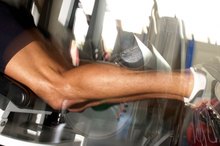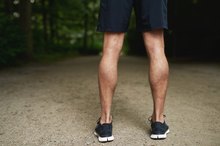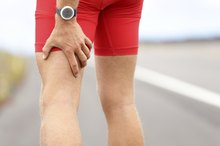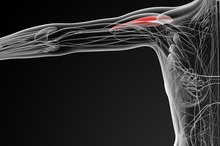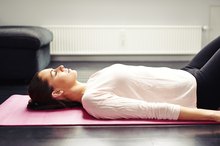What Are the Treatments for Muscle Strain of One Side of the Buttocks?
**Your buttocks have several layers of muscle.
If you are experiencing serious medical symptoms, seek emergency treatment immediately.
These muscles primarily move your hip joint, and straining them can literally be a pain in the butt. These strains typically occur on one side of the body when a muscle is overstretched or overworked. You can injure it in sports, heavy lifting, direct trauma or repetitive movements, such as squatting. ** Treatment for these injuries varies based on the intensity of your pain and the extent of muscle damage.
Home Remedies
Basic home remedies, including rest and ice, are used to treat muscle strains.
Avoid activities that increase any pain in your buttocks for several days or until your pain subsides. Ice can be applied to the area 3 to 5 times each day for 20 minutes.
Prescription Medications
Knots & Pain in Lower Leg
Learn More
Pain that does not improve within a few days may require a trip to your doctor. Medications are often prescribed to decrease inflammation and pain caused by a muscle strain. These may include oral steroids such as a Medrol Dose Pack, prescription-strength NSAIDs such as diclofenac (Voltaren) and muscle relaxants, such as cyclobenzaprine (Flexeril). Topical medications may be applied directly to the sore area. According to a study published in 2010 in "Journal of Pain Research," the diclofenac medicated patch is effective in the treatment of muscle strains 2.
Because it delivers medication directly to the injured area, you may experience fewer or less intense side effects than you would with oral medications. Your doctor may also inject corticosteroid medications, such as cortisone, directly into the injured muscle.
Platelet-rich plasma therapy is sometimes used to treat a strained muscle 5. **Blood is drawn from your body and processed to produce a concentrated amount of platelets in blood plasma -- the fluid that carries your blood cells.
** The plasma is injected back into your body, at the site of your strained muscle. Although this treatment is not yet common, PRP may speed up the healing process for muscle strains, according to a study published in June 2009 in "The American Journal of Sports Medicine."
- Pain that does not improve within a few days may require a trip to your doctor.
- Although this treatment is not yet common, PRP may speed up the healing process for muscle strains, according to a study published in June 2009 in "The American Journal of Sports Medicine."
Physical Therapy
Physical therapy is sometimes prescribed to treat muscle strains in the buttocks. Your therapist may use heat, ice, ultrasound and electrical stimulation to decrease pain and inflammation to speed the healing process. Exercises are performed to gently stretch your injured muscle and later strengthen it once your pain has calmed down. The therapist may also use massage and manual stretching to decrease muscle tightness and improve flexibility.
- Physical therapy is sometimes prescribed to treat muscle strains in the buttocks.
- Your therapist may use heat, ice, ultrasound and electrical stimulation to decrease pain and inflammation to speed the healing process.
Trigger Points
Golf & Rhomboid Strain
Learn More
Muscle strains may cause especially painful areas to develop, called trigger points.
These areas form a hard lump and cause twitching that can be felt when you press into the muscle. Trigger points are treated with massage and sustained pressure applied by another person, or a firm object, such as a tennis ball. Try this method at home -- lie on the floor on your back and place a tennis ball under the painful area of your buttocks. Lie down on the ball, and hold this position for several minutes until the pain subsides. This method temporarily reduces blood flow to the trigger point, reducing your pain and relaxing the muscle.
Alternative methods are also used to treat trigger point pain. Dry needling is a technique used to decrease pain caused by muscle strain. A thin needle is inserted into the trigger point at the source of your pain.
It is then repeatedly inserted and removed from the area until your muscle stops twitching and your pain has subsided.
According to a study published in 2005 in "British Journal of Sports Medicine," patients reported decreased pain in the muscles of the buttocks with dry needling 3. The assessments the researchers used failed to demonstrate its effectiveness.
- Muscle strains may cause especially painful areas to develop, called trigger points.
- Try this method at home -- lie on the floor on your back and place a tennis ball under the painful area of your buttocks.
Related Articles
References
- Sports Health: Posterior Hip Pain in an Athletic Population
- Journal of Pain Research: Topical Nonsteroidal Anti-Inflammae Treatment of Pain Due to Soft Tissue Injury -- Diclofenac Epolamine Topical Patch
- British Journal of Sports Medicine: Effect of Dry Needling of Gluteal Muscles on Straight Leg Raise: A Randomised, Placebo Controlled, Double Blind Trial
- British Journal of Sports Medicine: Hamstring Muscle Strain Injuries: What Can We Learn From History?
- The American Journal of Sports Medicine: Use of Autologous Platelet-Rich Plasma to Treat Muscle Strain Injuries
- The Journal of Orthopaedic and Sports Physical Therapy: Hamstring Strain Injuries: Recommendations for Diagnosis, Rehabilitation and Injury Prevention
- Cleveland Clinic. Muscle Pain: Possible Causes. Updated December 3, 2017.
- American Academy of Orthopaedic Surgeons. Sprains, Strains and Other Soft-Tissue Injuries. Updated July 2015.
- Allen RE, Kirby KA. Nocturnal leg cramps. Am Fam Physician. 2012;86(4):350-5.
- Jafri MS. Mechanisms of Myofascial Pain. Int Sch Res Notices. 2014;2014:523924. doi:10.1155/2014/523924
- American Academy of Orthopaedic Surgeons. Compartment Syndrome. Updated October 2009.
- Genetic and Rare Diseases Information Center. Pyomyositis.
- Centers for Disease and Prevention. Flu Symptoms & Complications. Updated September 18, 2019.
- Barry AR, Beach JE, Pearson GJ. Prevention and management of statin adverse effects: A practical approach for pharmacists. Can Pharm J (Ott). 2018;151(3):179–188. doi:10.1177/1715163518768534
- Ozaras N, Rezvani A. Diffuse skeletal pain after administration of alendronate. Indian J Pharmacol. 2010;42(4):245–246. doi:10.4103/0253-7613.68435
- Younus J, Kligman L. Management of aromatase inhibitor-induced arthralgia. Curr Oncol. 2010;17(1):87–90. doi:10.3747/co.v17i1.474
- National Institute of Arthritis and Musculoskeletal and Skin Diseases. Fibromyalgia. Updated July 2014.
- Centers for Disease Control and Prevention. What is ME/CFS? Updated July 12, 2018.
- Arthritis Foundation. Polymyalgia Rheumatica.
- Centers for Disease Control and Prevention. Rheumatoid Arthritis (RA). Updated March 5, 2019.
- Merck Manual Professional Version. Systemic Lupus Erythematosus (SLE). Updated Feb 2018.
- National Institute of Neurological Disorders and Stroke. Inflammatory Myopathies Fact Sheet. Updated August 13, 2019.
- National Organization for Rare Disorder. Addison's Disease. Updated 2018.
- Cleveland Clinic. Osteomalacia. Updated August 14, 2018.
- Torres PA, Helmstetter JA, Kaye AM, Kaye AD. Rhabdomyolysis: pathogenesis, diagnosis, and treatment. Ochsner J. 2015;15(1):58–69.
Writer Bio
Aubrey Bailey has been writing health-related articles since 2009. Her articles have appeared in ADVANCE for Physical Therapy & Rehab Medicine. She holds a Bachelor of Science in physical therapy and Bachelor of Arts in psychology from the University at Buffalo, as well as a post-professional Doctor of Physical Therapy from Utica College. Dr. Bailey is also a certified hand therapist.
